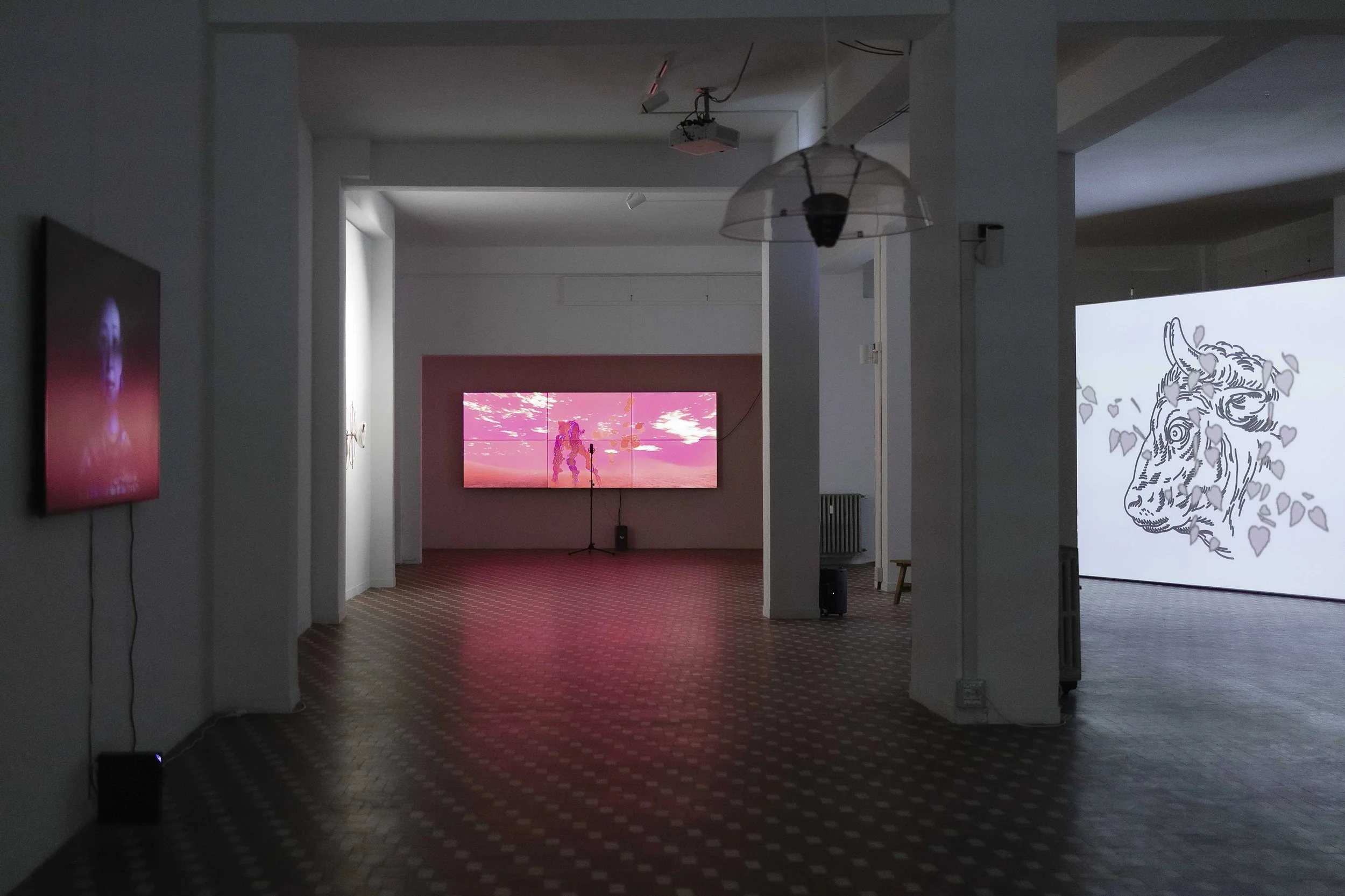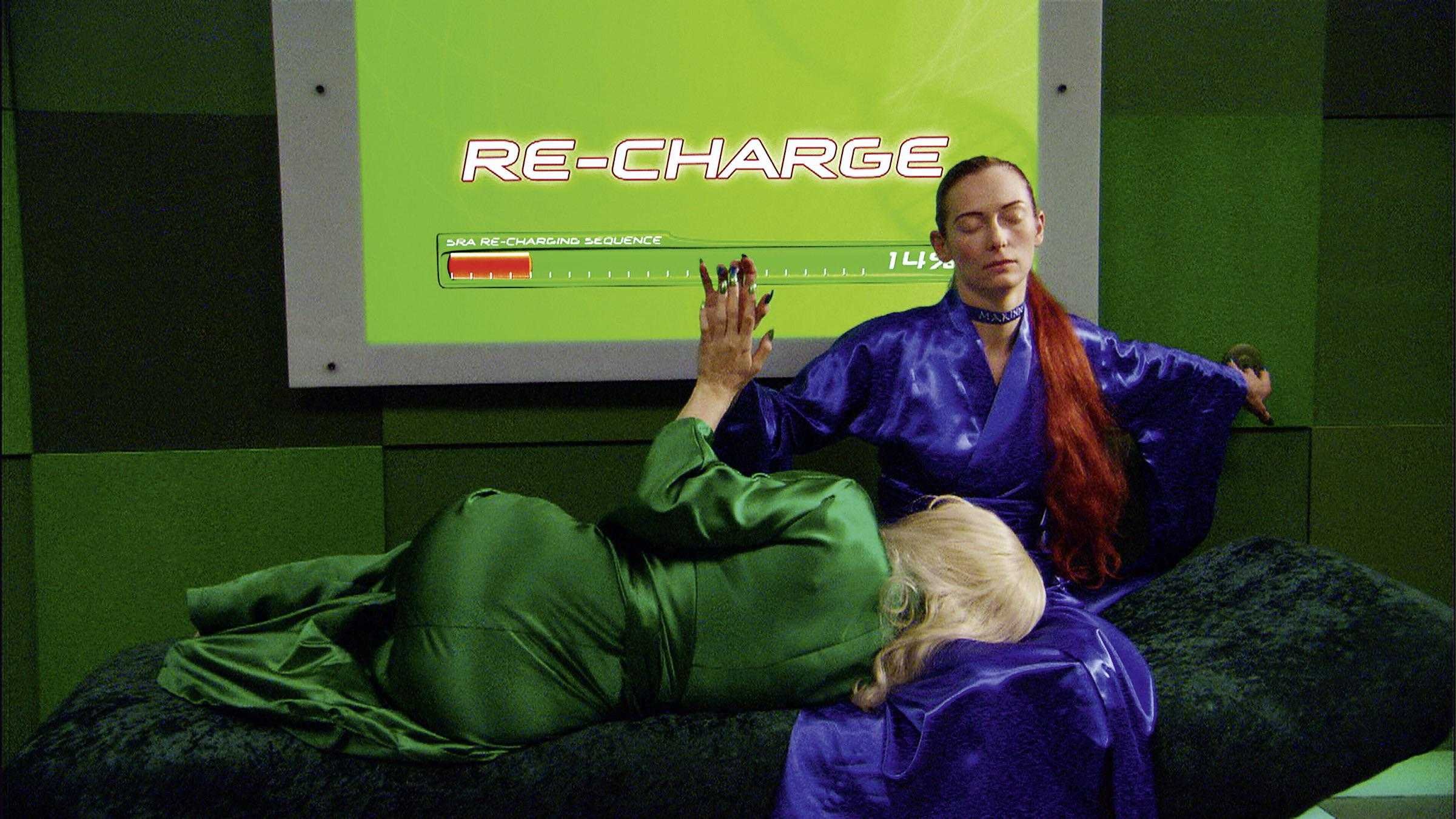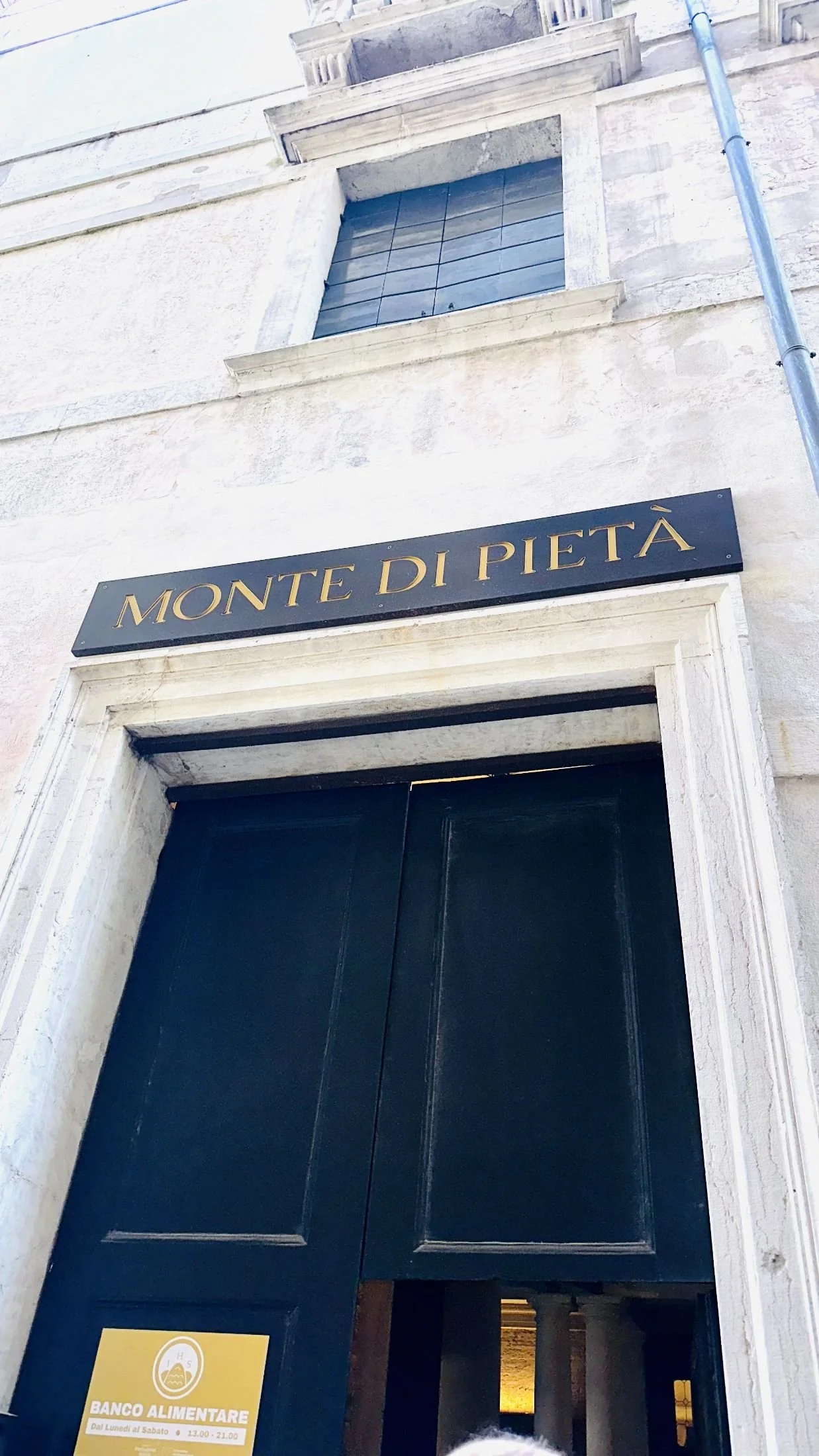Blood-child. Scenes from a Symbiosis
Blood-child. Scenes from a Symbiosis is the third project of the Fondazione Spazio Vitale, which celebrates its first anniversary this October. The Foundation is a non-profit space that studies the relationship between human and technology through critical research and artistic practice. The curator of the space, Domenico Quaranta, is a contemporary art critic and curator, whose research focused on the impact of the current techno-social developments on the arts, with a specific focus on art in networked spaces, from the Internet to virtual worlds.
The project continues the research and invites us to reflect on what the symbiosis of human and technology can be: in the exhibition’s narrative, the “bloodchild” is the human to come as a result of these relations. The exhibition presents works by four international artists – Ivana Bašić, Lynn Hershman Leeson, Oliver Laric and Sahej Rahal, and compares their positions: investigating weaknesses, delving into the reasons for discomfort, but also proposing perspectives for healing, trying to restore the balance between the two actors and a way to harmonious coexistence.
Bloodchild. Scenes from a Symbiosis, Fondazione Spazio Vitale
1. Lynn Hershman Leeson, Logic Paralyzes the Heart, 2022. Video installation, 12,00 min. Courtesy of the artist, Bridget Donahue NYC, Altman Siegel SF, Wouters Gallery Brussels.
2. Sahej Rahal, Druj, 2021. AI program, interactive installation. Courtesy of the artist.
3. Oliver Laric, Exoskeleton, 2022. Video, 3.12 min, loop. Courtesy Tanya Leighton, Berlin
In the 21st century the concept of reality is increasingly difficult to define, and it is even more difficult to define in which of the realities – real or virtual – we are most represented. Our faces and bodies have long been scanned, and sometimes their shape and appearance become more present in the reflection of the screen than in the mirror.
This leads to feelings of derealisation, constant disconnection and anxiety. The body inevitably suffers from this apparent marginalization, this reduction to a mere substrate and source of information: according to the philosopher Federico Campagna, ‘mutated, torn to pieces and chained to the millstone of information, a humanbeing, like every other existing being, can only scream with pain’.
Sahej Rahal, Druj, 2021. AI program, interactive installation. Courtesy of the artist.
But can we and technology coexist organically? The curator of the exhibition, Domenico Quaranta, refers to the research of the information theorist Giuseppe O. Longo, who introduces the term homo technologicus. According to Longo, the relationship between man and technology is a symbiotic one, and the homo technologicus that emerges from this relationship and co-evolution is a symbiont. In this context, discomfort is a consequence of the 'growing imbalance between the biological and technological parts of the symbiont'.
The most interesting aspect of the symbiotic metaphor is that it does not deny this imbalance, but suggests that we approach it from a finalist perspective. Longo invites us to anticipate further developments in the relationship and to consider what steps are necessary to build a functional and constructive relationship in which we, as hosts, must set the limit.
1. Oliver Laric, Reclining Pan, 2021. SLS Nylon, SLA resin, acrylic paint, aluminium base 145.7×151.7×83.7 cm. Edition of 6 + 2 AP. Courtesy Tanya Leighton, Berlin.
2. Ivana Bašić, I sense that all of this is ancient and wast. I had touched the nothing, and nothing was living and moist #2, 2022. White alabaster, wax, copper, pressure, grounding rods, stainless steel, 66×47×19,5 cm. Courtesy Francesca Minini, Milano.
Blood-child. Scenes from a Symbiosis features works by Ivana Bašić, Lynn Hershman Leeson, Oliver Laric and Sahej Rahal which represent possible developments of the relationship between the biological and technological.
The first thing we see walking into the space are two brightly lit screens in front of us with video artworks by Sahej Rahal (Druj, 2021) and Oliver Laric (Exoskeleton, 2022). Sahej Rahal lives and works in Mumbai, he is a storyteller who interweaves fact and fiction to create counter-mythologies that interrogate narratives shaping the present. In the context of his work, “Druj” – named after an Iranian deity who personifies cunning – is part of an ongoing series of simulations or biomes, in which the behavior of one or more living entities is conditioned by sound. In the work, the creature reacts to the audio input from outside, to the voice or noises produced by the viewer, changing shape in response to the sounds.
The exhibition also features his work “DMT” (Distributed Mind Test, 2024) – a сooperative multiplayer game, in which you can play and be transported to a post-apocalyptic world, controlled by artificial intelligence, where humans survive in the form of traces and memories.
Oliver Laric, Reclining Pan, 2021. SLS Nylon, SLA resin, acrylic paint, aluminium base 145.7×151.7×83.7 cm. Edition of 6 + 2 AP. Courtesy Tanya Leighton, Berlin.
Oliver Laric’s video "Exoskeleton” questions the boundaries between organic and inorganic, natural and artificial, geometric and biomorphic, returning to his sculpture "Reclining Pan". Son of Hermes, torso of a man and legs of a goat, god of the forests and grasslands, Pan is the hybrid par excellence, and it is not surprising that his figure has assumed a prominent role in the sculptural canon of Oliver Laric, who has been intent for years on returning the images of tradition to the public domain and reinterpreting their uninterrupted flow and evolution by experimenting with the materials and production processes of rapid prototyping.
Lynn Hershman Leeson, Logic Paralyzes the Heart, 2022. Video installation, 12,00 min. Courtesy of the artist, Bridget Donahue NYC, Altman Siegel SF, Wouters Gallery Brussels.
Video installation “Logic Paralyzes the Heart” by Lynn Hershman Leeson was created for the Venice Biennale "The Milk of Dreams" (2022) and introduces us to Cyborg #1, played by Joan Chen, who traces the history of AI and its roots in the technologies of warfare and surveillance to arrive at an optimistic prediction of the coexistence of humans and cyborgs. The monologue is the result of a collaboration between Leeson and a ChatGPT3 trained on techno-utopian texts.
Lynn Hershman Leeson is the new-media pioneer, artist and filmmaker who for the last five decades investigating the relationships between humans and technology, identity, surveillance, and the use of media as a tool of empowerment against censorship and political repression. On the underground floor of the Fondazione Spazio Vitale you can also watch her “Teknolust” (2002) – feminist and caustic feature film, in which bioengineer Rosetta Stone (Tilda Swinton) creates three cyborg clones of herself, animated by artificial intelligence, which ironically imagines the forms of coexistence – and mutual dependence – between man and machine.
Ivana Bašić, Belay My Light, the Ground Is Gone, 2018. Wax, pink alabaster, blown glass, breath, dust, weight, oil paint, pressure, stainless steel, 139.7 x 228.6 x 152.4 cm. Courtesy Francesca Minini, Milano.
Opposite the screen with the film, we see the culmination of the exhibition and a literal symbiont of human and technology, – an alien sculpture by Ivana Bašić “Belay My Light, the Ground Is Gone” (2018) of wax, alabaster, glass and steel, reality and tangibility of which, for a moment, makes us doubt the reality of the present. Observing Ivana Bašić’s work, we recognize the human just enough to feel empathy. As she said in an interview, “I’m trying to find a very delicate balance, where you don’t back away, but get pulled in to contemplate the unknown with a kind of tender curiosity – and recognize the other within yourself.”
The title of the exhibition refers to the short story of American writer Octavia L. Butler Bloodchild (1984) where a group of humans landed on an alien planet and had to build a sacrificial alliance with an alien species, which, however, helped both survive in a hostile place. According to Butler, this story is not about slavery, despite some critics' interpretations, but about a loving symbiotic relationship between two very different species.
The development of technologies is inevitable, so building a loving symbiotic relationship would be nice. As Domenico Quaranta notes – “after all, the challenge we are facing is the same one we have been fighting since we first turned thing into a tool”.
Lynn Hershman Leeson, Teknolust, 2002. Film, 83,00 min. Courtesy of the artist, Bridget Donahue NYC, Altman Siegel SF, Wouters Gallery Brussels, Hotwire Productions LLC.
A must-see during Art Verona, which will take place from 11 to 13 October.
Fondazione Spazio Vitale
Via San Vitale 5 - Verona
Words and photography: Sofia Guzzo @sophia.guzzo
What to read next

















